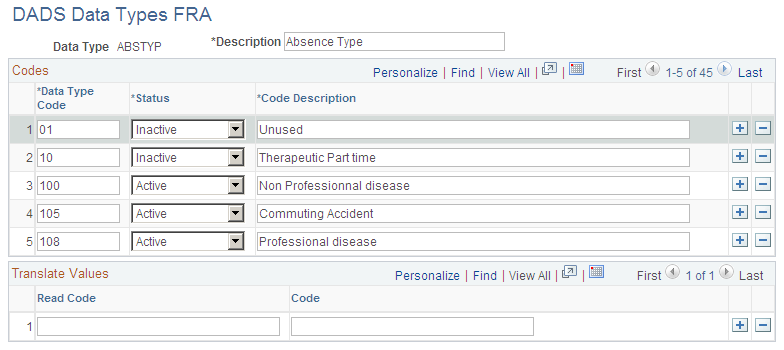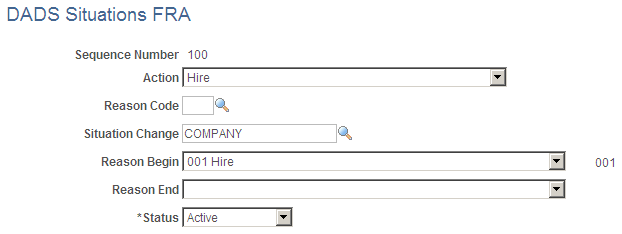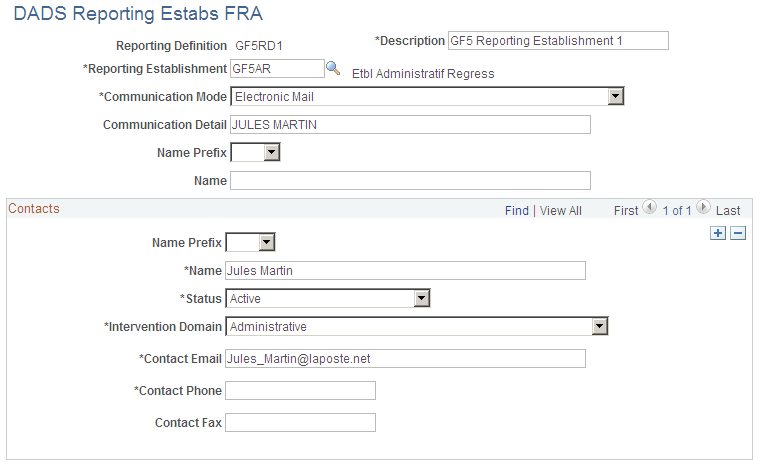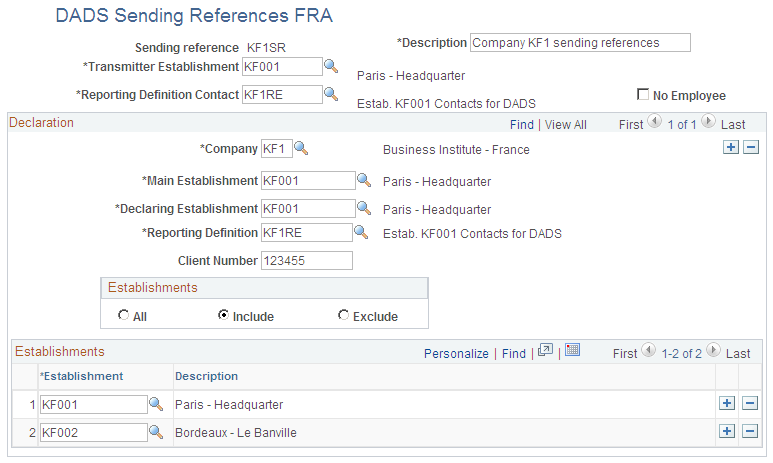Setting Up DADS Extraction
To set up DADS extraction, use the DADS Data Types FRA (GPFR_DA_DATTYP), DADS Reporting Estabs FRA (GPFR_DA_ESTREP), DADS Situations FRA (GPFR_DA_SIT), and DADS Sending References FRA (GPFR_DA_SNDREF) components.
Use the CI_GPFR_DA_DATTYP component interface to import data into the tables for the DADS Data Types FRA component. Use the CI_GPFR_DA_SIT component interface to import data into the tables for the DADS Situations FRA component.
|
Page Name |
Definition Name |
Usage |
|---|---|---|
|
GPFR_DA_DATTYP |
View data types and translate values. This list contains information for each data type defined by unified DADS requirements. |
|
|
GPFR_DA_SIT |
Define the DADS beginning and end situation codes. |
|
|
GPFR_DA_ESTREP |
Define reporting establishments and contacts. |
|
|
GPFR_DA_SNDREF |
Define the layout of the output file. One file is a set of declared companies, which comprise groups of employees called establishments. |
|
|
Application Definition Page |
GPFR_AF_APPL |
Define the labels for node sets, nodes and attributes for a given Application Framework application. |
|
Define Parameter Template Page |
GPFR_AF_PRM_TEMPLT |
Define parameters, grouped into functions, for a given application. |
|
Node Set Definition Page |
GPFR_AF_NODE_SET |
Lists all possible node sets, such as DADS-U messages. |
|
Security Record List Page |
GPFR_AF_APP_SECRTY |
In the event of incorrect setup, this transaction avoids the accidental deletion of important tables, such as the JOB table, while executing Data Object Names. |
|
Node Set Nodes Page |
GPFR_AF_NODE_SET_N |
Displays the list of node sets defined in the Define Application / Node Set component, on the Node Set Definition page, and the list of structures associated with each node set. |
|
Node Set Attributes Page |
GPFR_AF_NODE_SET_A |
Provides another view of the records associated with a node set, which enables you to see all of the records, for all structures. |
|
Define Node FRA Page |
GPFR_AF_NODE |
Contains all of the data used for the processing of structures and records. However, you can override some parameters at the Run Control stage. |
|
SQL Entity Definition/Mapping Page |
GPFR_AF_SQL_ENTITY |
Define an SQL entity for a given application. |
|
SQL Entity Template Page |
GPFR_AF_SQL_TMPLT |
Define an SQL entity template. |
|
Define Data Object Name FRA Page |
GPFR_AF_DON |
Define a data object name, which is the final object executed to populate a given record. A DON is composed of one or more SQL sequences. |
|
Define Mapping Code FRA Page |
GPFR_AF_MAPCODE_PG |
Defines the one-to-one mappings between HCM data and DADS-U official codes. Complex relationships between HCM data and DADS-U codes must be managed through a Data Object Name. |
|
View SQL/DON Relationship FRA Page |
GPFR_AF_SQLDON_REL |
View the relationships between SQL and data object names. |
|
View DON/Attr Relationship FRA (view data object name/attribute relationship FRA) Page |
GPFR_AF_DONATR_REL |
View the records that use a data object name. |
|
Duplicate Objects FRA Page |
GPFR_AF_DUP_DATA |
Duplicate SQL entities and DONs, for customization purposes. |
Use the DADS Data Types FRA page (GPFR_DA_DATTYP) to view data types and translate values.
This list contains information for each data type defined by unified DADS requirements.
Navigation:
This example illustrates the fields and controls on the DADS Data Types FRA page. You can find definitions for the fields and controls later on this page.

Use data types to translate DADS records used in the report. When you add or modify a DADS data record, data types provide a view of the description instead of only the DADS record code number.
Field or Control |
Description |
|---|---|
Read Code |
Maps the field value to the DADS structure code that you specify in the associated Code field. The field value is extracted from the PeopleSoft application. |
Code |
DADS structure code translated from the Read Code field. |
Use the DADS Situations FRA page (GPFR_DA_SIT) to define the DADS beginning and end situation codes.
Navigation:
This example illustrates the fields and controls on the DADS Situations FRA page. You can find definitions for the fields and controls later on this page.

In the DADS report, structure S41 contains social and fiscal data as well as gross salary, net salary, contribution funding base, and so forth. A new S41 is created each time an employee DADS situation changes. Using the DADS Situations FRA page, you can link PeopleSoft employee record changes to corresponding DADS situation changes.
Field or Control |
Description |
|---|---|
Action |
Enter the action that triggers the situation change. |
Reason Code |
Enter the reason for the action that triggers the DADS situation change. |
Situation Change |
Enter the type of situation change. Values vary depending on the employee record. Values are stored in the DADS writable array DAS WA SITUAT S41. |
Reason Begin |
Enter the reason corresponding to the new DADS situation. Values are defined in the STREAS data type. The code corresponding to the Reason Begin is declared in the record S41.G01.00.002.001 |
Reason End |
Select the reason corresponding to the end of the previous DADS situation. Values are defined in the ENDREAS data type. If no value is selected in the Reason Begin field, this field corresponds to the end reason of the current DADS situation. The code corresponding to the Reason End will be declared in the record S41.G01.00.004.001. Note: The latest DADS norm provides up to 5 records for declaring the situation change code– S41.G01.00.002.001 to 005 for the Reason Begin code and S41.G01.00.004.001 to 005 for the Reason End code. The different records and codes are used when there are several changes that occur on the same date. For example, if an employee is promoted to manager and transfered to a new establishment on the same date, those two actions can be declared using situation change codes. However, PeopleSoft only populates one reason begin and reason end code. The reason for this is that the codes 002 to 005 are optional and informational. PeopleSoft records only one code based on the sequence order used to record the situation change. In the example above, if the sequence order for the employee category change (from non-manager to manager) is 100 and the sequence order for the establishment transfer is 200, then only the category change reason codes will be declared. |
Use the DADS Reporting Estabs FRA page (GPFR_DA_ESTREP) to define reporting establishments and contacts.
Navigation:
This example illustrates the fields and controls on the DADS Reporting page. You can find definitions for the fields and controls later on this page.

DADS Reporting Establishment page allows defining the reporting establishments and the contacts within these establishments. The reporting establishments created are referenced in the Sending Reference setup.
Field or Control |
Description |
|---|---|
Reporting Establishment |
Enter the establishment code. One reporting establishment must be set up for each declared company. Use this page to define the reporting establishment and the information related to the establishment (such as people to contact and communication mode with DADS) that is used in structure 10. |
Communication Mode |
Enter the transmission method for the DADS log file. Valid values are Electronic Mail and Postal Mail. |
Communication Detail |
Values vary depending on the communication mode: Electronic Mail: Enter the email address. Postal Mail: Enter specific contact data, such as a phone number. |
Name Prefix |
Enter the name prefix for person who can be contacted by the DADS organization representatives. |
Name |
Enter the name of the person who can be contacted by the DADS organization representatives. |
Contacts
Field or Control |
Description |
|---|---|
Name Prefix |
Enter the name prefix for the contact. |
Name |
Enter up to three active contacts for each reporting establishment. |
Status |
Select a status. A status of Active indicates that a contact must be used. |
Intervention Domain |
Select Administrative, Computing, or Other. |
Contact Email |
Enter the email address of the contact. Note: The underscore character "_" may be used in this field. |
Contact Phone |
Enter the phone number of the contact. |
Contact Fax |
Enter the fax number of the contact. |
Use the DADS Sending References FRA page (GPFR_DA_SNDREF) to define the layout of the output file.
One file is a set of declared companies, which comprise groups of employees called establishments.
Navigation:
This example illustrates the fields and controls on the DADS Sending References FRA page. You can find definitions for the fields and controls later on this page.

Sending reference information is used in structures S10 and S20 to identity the transmitter and company of the declaration. It is also used in structure S80 to identify establishments to be included in the declaration.
Field or Control |
Description |
|---|---|
Transmitter Establishment |
Enter an establishment defined in the PeopleSoft HR Establishment table. The transmitter establishment is declared in record S10.G01.00.001 and S10.G01.00.001.002 (transmitter SIREN plus NIC number). |
Reporting Definition Contact |
Select an entry defined on the Reporting Establishment page. The reporting establishment contact must be indicated for the sending reference. A reporting establishment contact can be used several times for different sending references. Data from the reporting definition populates the records S10.G01.00.013.001 and S10.G01.00.013.002 (log file recipient SIREN and NIC) as well as the transmitter contact information (S10.G01.01 structure). |
No Employee |
Select if there are no employees to declare for the report. If selected, all the establishments in the Establishment List in the page must have employed no staff during the declared year. The file generated must have a recipient type of None. No S30 structure must be present in the file; the record S20.G01.00.004.001 is equal to the code 05 for DADS-U empty and the record S20.G01.00.004.002 is equal to the code 55 for Code Type declaration None. |
Company |
Enter the company that is part of the DADS file for the defined sending reference. The company is declared in the record S20.G01.00.001 (SIREN number). |
Main Establishment |
Enter a main establishment. For each declared company, the main establishment must appear on the establishments list. The main establishment is declared in the record S20.G01.00.008 (main establishment NIC). |
Declaring Establishment |
Enter a declaring establishment. You can use the value that appears in the Main Establishment field. The declaring establishment is reported in the record S20.G01.00.010 (NIC number). |
Reporting Definition |
Select an entry defined on the Reporting Establishment page. The Reporting Establishment must be indicated for each company. The reporting definition information is used to declare the records S20.G01.00.014.001 to S20.G01.00.016 (SIREN plus NIC numbers). |
Client Number |
Optional. Enter a client number. The client number is declared in the record S20.G01.00.013. This field can be used when the transmitter of the DADS attributes a client to the companies he declares, for example for accounting firms performing declarations for their clients. |
All |
Select to declare all establishments. |
Include |
Select to declare only the establishments displayed on the page. |
Exclude |
Select to declare all establishments except those listed on the page. |
Establishment and Description |
Enter at least one establishment. The establishment lists the employees to be processed. |